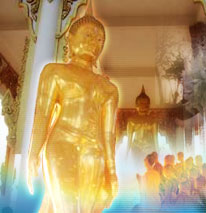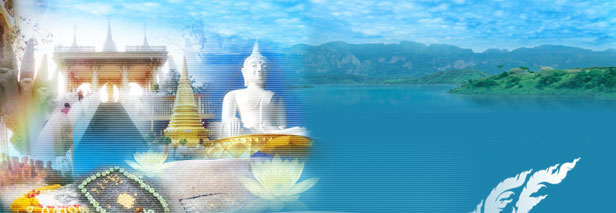|
 |
 |
![[*]](./images/corporate/default_icon.gif) posted on 26/6/08 at 18:18 posted on 26/6/08 at 18:18 |

|
น.พ.เอียน สตีเวนสัน ได้สำรวจผู้ระลึกชาติมาแล้ว 3,000 กว่าราย
อัลเบิร์ต ไอสไตน์ กล่าวถึง "พระพุทธศาสนา" ก่อนเสียชีวิต
มหาวิทยาลัยปรินซ์ตัน ได้ตีพิมพ์งานเขียนชิ้นหนึ่งของเขาชื่อเรื่อง " The Human Side " ซึ่งนักฟิสิกส์ผู้ที่ได้รับรางวัลโนเบลผู้นี้
ได้กล่าวทิ้งท้ายให้เป็นปริศนาแห่งโลกอนาคตว่า..
"...The religion of the future will be a cosmic religion. It should transcend personal God and avoid dogma and
theology. Covering both the natural and the spiritual, it should be based on a religious sense arising from the experience of all things natural and
spiritual as a meaningful unity. Buddhism answers this description. If there is any religion that could cope with modern scientific needs it would be
Buddhism...." (Albert Einstein)
"...ศาสนาในอนาคต จะต้องเป็น "ศาสนาสากล" ศาสนานั้น..ควรอยู่เหนือ "พระเจ้า" ที่มีตัวตน และควรจะเว้นคำสอนแบบ
"สิทธันต์" (คือเป็นแบบสำเร็จรูปที่ให้เชื่อตามเพียงอย่างเดียว) และแบบ "เทววิทยา" (คือพึ่งเทวดาเป็นหลักใหญ่)
ศาสนานั้น..เมื่อครอบคลุมทั้งธรรมชาติและจิตใจ จึงควรมีรากฐานอยู่บนสามัญสำนึกทางศาสนาที่เกิดขึ้นจากประสบการณ์ต่อสิ่งทั้งปวง คือ
ทั้งธรรมชาติและจิตใจอย่างเป็นหน่วยรวมที่มีความหมาย "พระพุทธศาสนา" ตอบข้อกำหนดนี้ได้
ถ้าจะมีศาสนาใดที่รับมือได้กับความต้องการทางวิทยาศาสตร์สมัยใหม่ปัจจุบัน ศาสนานั้น..ก็ควรเป็น... "พระพุทธศาสนา"
อัลเบิร์ต ไอน์สไตน์
นักฟิสิกส์ ชาวเยอรมัน ผู้เสนอทฤษฏีสัมพัทธภาพ
คำพูดของไอสไตล์นั้นมีความนัยที่สำคัญซ่อนอยู่และรอค อยการค้นพบ และทฤษฎีเอกภาพหรือทฤษฎีสรรพสิ่งที่ต้องการค้นหานั้น
ที่จริงพระพุทธเจ้าได้ตอบให้เบ็ดเสร็จก่อนหน้านั้น 2500 ปี
[1954, from Albert Einstein:The Human Side, edited by Helen Dukas and Banesh Hoffman, Princeton University Press]
ศาสนาพุทธ เเละ วิทยาศาสตร์ อยู่บนวิถีทางเดียวกัน คือ เรื่องของความจริง เเต่ศาสนาพุทธนอกจากจะ "ความจริงเเล้ว"
ยังสอนให้เราหลุดพ้นไปจากความจริงนั้นได้ด้วย ขณะที่วิทยาศาสตร์จะหยุดอยู่เเค่ "ความจริง" เท่านั้น
อะไรคือความจริงแท้ .. "ความจริง" คืออะไร
ตอบว่า.. ความจริงแท้ คือ สิ่งที่พิสูจน์ได้ ด้วยอุปกรณ์ และทฤษฎีทางวิทยาศาสตร์ แต่..อุปกรณ์ทางวิทยาศาสตร์ ก็ยังพิสูจน์ความมีอยู่จริงของ นรก สวรรค์
และ มรรค ผล นิพพาน ไม่ได้
แต่..พุทธศาสนาท้าให้พิสูจน์ด้วยการเจริญวิปัสสนากรร มฐาน มาตลอด 2000 ปี เมื่อยังมีผู้ตัดสินใจบวชถวายชีวิตในพุทธศาสนาอยู่ นั่นก็แสดงว่า
ผู้นั้นได้ยอมจำนนต่อคำสอนของพระพุทธเจ้าอย่างไม่มีเ งื่อนไข..นี่แล..คือความจริง เหนือจริงของพุทธศาสนา
บทพิสูจน์
งานวิจัยเรื่อง 20 ผู้กลับชาติมาเกิด โดย Ian Stevenson, M.D. (ศาสตราจารย์ น.พ.เอียน สตีเวนสัน) มหาวิทยาลัยเวอร์จิเนีย พิมพ์โดย อภิธรรมมูลนิธิ
หน้าพุทธมณฑล อ. พุทธมณฑล จ. นครปฐม 73170
อ่านต้นฉบับภาษาอังกฤษได้ที่ :
http://books.google.com/books?id=vID...nW9Q#PPA184,M1
และที่ ดร.ฝรั่งระลึกชาติ อ่านได้ที่ : http://www.drsusanfisher.com/reading.html
เป็นอันว่า ถ้าเรื่องไม่จริง เด็ก 2 ขวบ จะรู้จักชื่อของลูกเมีย ญาติพี่น้องของตนในชาติก่อนได้อย่าง โดยที่ "ศาสตราจารย์ น.พ.เอียน สตีเวนสัน"
ได้นำเด็กคนนั้น...ไปหาญาติพี่น้องตามที่เด็กกล่าวอ้าง จนพบจริง ๆ ในประเทศบลาซิล มีอยู่ถึง 6 คน...
ที่มา : โดย..Montasavi
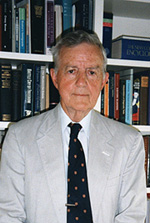
Dr. Ian Stevenson

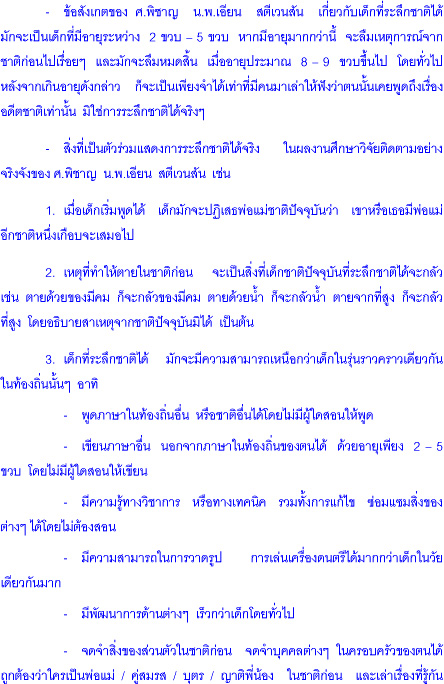
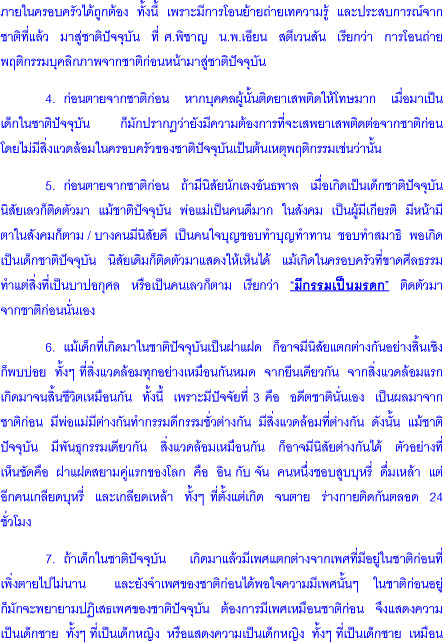
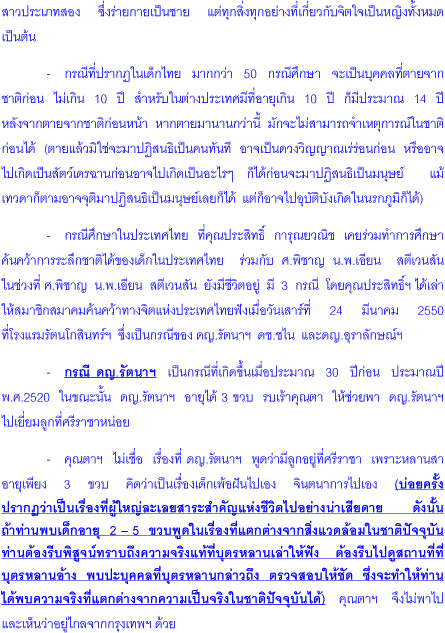
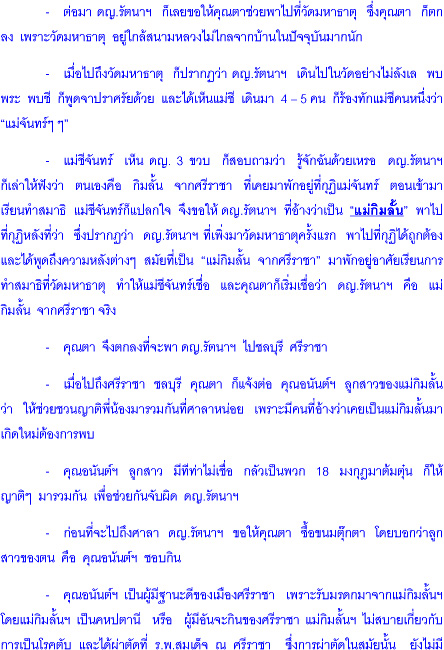

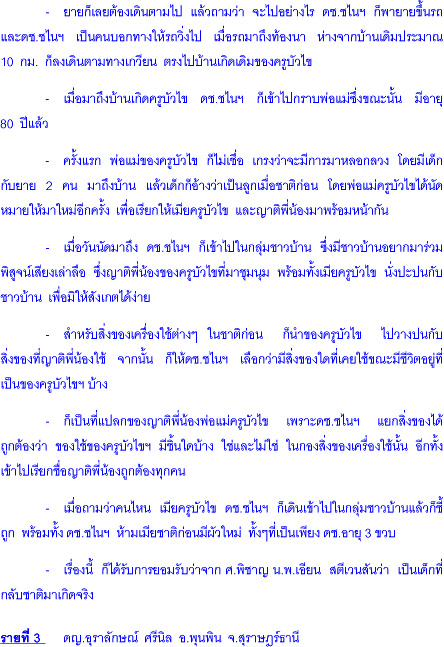
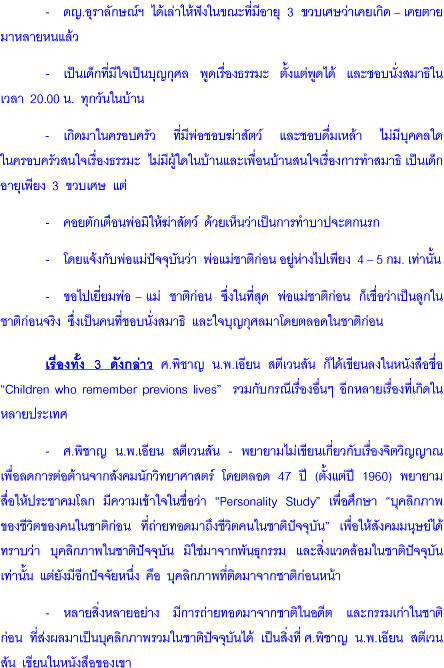
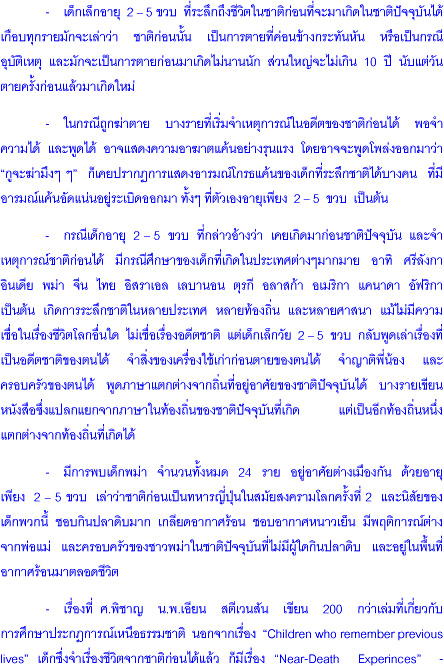
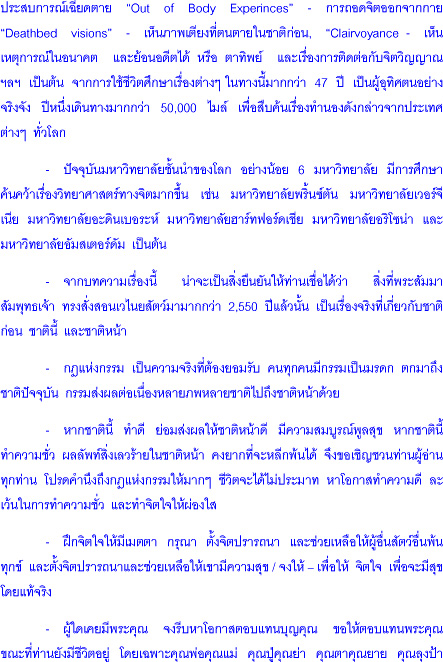

Dr. Ian Stevenson
The Pioneer of Reincarnation Research
Ian Stevenson is the former head of the Department of Psychiatry at the University of Virginia, and now is Director of the Division of Perceptual
Studies at the University of Virginia. He has devoted the last 40 years to the scientific documentation of past life memories of children from all
over the world and has over 3000 cases in his files. Many people, including skeptics and scholars, agree that these cases offer the best evidence yet
for reincarnation.
Dr. Stevenson's research into the possibility of reincarnation began in 1960 when he heard of a case in Sri Lanka where a child claimed to
remember a past life. He thoroughly questioned the child and the child's parents, as well as the people whom the child claimed were his parents from
his past life.
This led to Dr. Stevenson's conviction that reincarnation was possibly a reality. The more cases he pursued, the greater became his drive to
scientifically open up and conquer an unknown territory among the world's mysteries, which until now had been excluded from scientific observation.
Nonetheless, he believed he could approach and possibly furnish proof of its reality with scientific means.
In 1960, Dr. Stevenson published two articles in the Journal of the American Society for Psychical Research about children who remembered past
lives. In 1974, he published his book, Twenty Cases Suggestive of Reincarnation, and became well known wherever this book appeared by those people who
already had a long-standing interest in this subject.
They were pleased to finally be presented with such fundamental research into reincarnation from a scientific source. In 1997, Dr. Stevenson
published his work entitled Reincarnation and Biology. In the first volume, he mainly describes birthmarks - those distinguishing marks on the skin
which the newborn baby brings into the world and cannot be explained by inheritance alone.
In his second volume, Dr. Stevenson focuses mainly on deformities and other anomalies that children are born with and which cannot be traced back
to inheritance, prenatal or perinatal (created during birth) occurrences. This monumental piece of work contains hundreds of pictures documenting the
evidence.
During his original research into various cases involving children's memories of past lives, Dr. Stevenson did note with interest the fact that
these children frequently bore lasting birthmarks which supposedly related to their murder or the death they suffered in a previous life.
Stevenson's research into birthmarks and congenital defects has such particular importance for the demonstration of reincarnation, since it
furnishes objective and graphic proof of reincarnation, superior to the - often fragmentary - memories and reports of the children and adults
questioned, which even if verified afterwards cannot be assigned the same value in scientific terms.
In many cases presented by Dr. Stevenson there are also medical documents available as further proof, which are usually compiled after the death
of the person. Dr. Stevenson adds that in the cases he researched and "solved" in which birthmarks and deformities were present, he didn't suppose
there was any other apposite explanation than that of reincarnation. Only 30% - 60% of these deformities can be put down to birth defects which
related to genetic factors, virus infections or chemical causes (like those found in children damaged by the drug Thalidomide or alcohol).
Apart from these demonstrable causes, the medical profession has no other explanation for the other 40% to 70% of cases than that of mere chance.
Stevenson has now succeeded in giving us an explanation of why a person is born with these deformities and why they appear precisely in that part of
their body and not in another.
Most of the cases where birthmarks and congenital deformities are present for which no medical explanations exist have one to five characteristics
in common.
(1) In the most unusual scenario, it is possible that someone who believed in reincarnation expressed a wish to be reborn to a couple or one
partner of a couple. This is usually because they are convinced that they would be well cared for by those particular people. Such preliminary
requests are often expressed by the Tlingit Indians of Alaska and by the Tibetans.
(2) More frequent than this are the occurrences of prophetic dreams. Someone who has died appears to a pregnant or not as yet pregnant woman and
tells her that he or she will be reborn to her. Sometimes relatives or friends have dreams like this and will then relate the dream to the mother to
be. Dr. Stevenson found these prophetic dreams to be particularly prolific in Burma and among the Indians in Alaska.
(3) In these cultures the body of a newborn child is checked for recognizable marks to establish whether the deceased person they had once known
has been reborn to them. This searching for marks of identification is very common among cultures that believe in reincarnation, and especially among
the Tlingit Indians and the Igbos of Nigeria. Various tribes of West Africa make marks on the body of the recently deceased in order to be able to
identify the person when he or she is reborn.
(4) The most frequently occurring event or common denominator relating to rebirth is probably that of a child remembering a past life. Children
usually begin to talk about their memories between the ages of two and four. Such infantile memories gradually dwindle when the child is between four
and seven years old. There are of course always some exceptions, such as a child continuing to remember its previous life but not speaking about it
for various reasons.
Most of the children talk about their previous identity with great intensity and feeling. Often they cannot decide for themselves which world is
real and which one is not. They often experience a kind of double existence where at times one life is more prominent, and at times the other life
takes over.
This is why they usually speak of their past life in the present tense saying things like, "I have a husband and two children who live in
Jaipur." Almost all of them are able to tell us about the events leading up to their death.
Such children tend to consider their previous parents to be their real parents rather than their present ones, and usually express a wish to
return to them. When the previous family has been found and details about the person in that past life have come to light, then the origin of the
fifth common denominator the conspicuous or unusual behavior of the child - is becoming obvious.
(5) For instance, if the child is born in India to a very low-class family and was a member of a higher caste in its previous life, it may feel
uncomfortable in its new family. The child may ask to be served or waited on hand and foot and may refuse to wear cheap clothes. Stevenson gives us
several examples of these unusual behavior patterns.
In 35% of cases he investigated, children who died an unnatural death developed phobias. For example, if they had drowned in a past life then they
frequently developed a phobia about going out of their depth in water. If they had been shot, they were often afraid of guns and sometimes loud bangs
in general. If they died in a road accident they would sometimes develop a phobia of traveling in cars, buses or lorries.
Another frequently observed unusual form of behavior, which Dr. Stevenson called philias, concerns children who express the wish to eat different
kinds of food or to wear clothes that were different from those of their culture. If a child had developed an alcohol, tobacco or drug addiction as an
adult in a previous incarnation he may express a need for these substances and develop cravings at an early age.
Many of these children with past-life memories show abilities or talents that they had in their previous lives. Often children who were members of
the opposite sex in their previous life show difficulty in adjusting to the new sex. These problems relating to the 'sex change' can lead to
homosexuality later on in their lives. Former girls who were reborn as boys may wish to dress as girls or prefer to play with girls rather than
boys.
Until now all these human oddities have been a mystery to conventional psychiatrists - after all, the parents could not be blamed for their
children's behavior in these cases. At long last research into reincarnation is shedding some light on the subject. In the past, doctors blamed such
peculiarities on a lack or a surplus of certain hormones, but now they will have to do some rethinking.
The following paper by Dr. Stevenson was presented at the Eleventh Annual Meeting of the Society for Scientific Exploration held at Princeton
University. June 11-13, 1992. The title of the paper is "Birthmarks and Birth Defects Corresponding to Wounds on Deceased Persons" and provides
perhaps the most compelling scientific evidence suggestive of reincarnation. Dr. Stevenson's paper presents evidence that physical characteristics,
such as birthmarks and deformities, may be carried over from a past life to a present life.
------------------------------------------------------------------------------------------------------------------------------------------
Birthmarks and Birth Defects Corresponding to Wounds on Deceased Persons
ABSTRACT
Ian Stevenson, Department of Psychiatric Medicine, University of Virginia, School of Medicine, Charlottesville, Virginia 22908
Almost nothing is known about why pigmented birthmarks (moles or nevi) occur in particular locations of the skin. The causes of most birth defects
are also unknown. About 35% of children who claim to remember previous lives have birthmarks and/or birth defects that they (or adult informants)
attribute to wounds on a person whose life the child remembers.
The cases of 210 such children have been investigated. The birthmarks were usually areas of hairless, puckered skin; some were areas of little or
no pigmentation (hypopigmented macules); others were areas of increased pigmentation (hyperpigmented nevi). The birth defects were nearly always of
rare types.
In cases in which a deceased person was identified the details of whose life unmistakably matched the child's statements, a close correspondence
was nearly always found between the birthmarks and/or birth defects on the child and the wounds on the deceased person. In 43 of 49 cases in which a
medical document (usually a postmortem report) was obtained, it confirmed the correspondence between wounds and birthmarks (or birth defects).
There is little evidence that parents and other informants imposed a false identity on the child in order to explain the child's birthmark or
birth defect. Some paranormal process seems required to account for at least some of the details of these cases, including the birthmarks and birth
defects.

(Figure 1. Hypopigmented macule on chest of an Indian youth who, as a child, said he remembered the life of a man, Maha
Ram, who was killed with a shotgun fired at close range.)
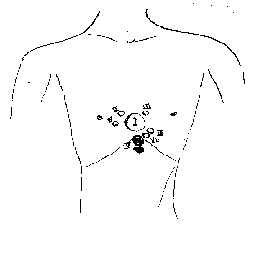
Figure 2. The circles show the principal shotgun wounds on Maha Ram, for comparison with Figure 1. [This drawing is fromthe autopsy report of the deceased.]
INTRODUCTION
Although counts of moles (hyperpigmented nevi) have shown that the average adult has between 15 and IX of them (Pack and Davis, 1956), little is
known about their cause -- except for those associated with the genetic disease neurofibromatosis -- and even less is known about why birthmarks occur
in one location of the body instead of in another.
In a few instances a genetic factor has been plausibly suggested for the location of nevi (Cockayne, 1933; Denaro, 1944; Maruri, 1961); but the
cause of the location of most birthmarks remains unknown. The causes of many, perhaps most, birth defects remain similarly unknown.
In large series of birth defects in which investigators have searched for the known causes, such as chemical teratogens (like thalidomide), viral
infections, and genetic factors, between 430/0 (Nelson and Holmes, 1989) and 65 -- 70% (Wilson, 1973) of cases have finally been assigned to the
category of "unknown causes."
Among 895 cases of children who claimed to remember a previous life (or were thought by adults to have had a previous life), birthmarks and/or
birth defects attributed to the previous life were reported in 309 (35%) of the subjects. The birthmark or birth defect of the child was said to
correspond to a wound (usually fatal) or other mark on the deceased person whose life the child said it remembered.
This paper reports an inquiry into the validity of such claims. With my associates I have now carried the investigation of 210 such cases to a
stage where I can report their details in a forthcoming book (Stevenson, forthcoming). This article summarizes our findings.
Children who claim to remember previous lives have been found in every part of the world where they have been looked for (Stevenson, 1983; 1987),
but they are found most easily in the countries of South Asia. Typically, such a child begins to speak about a previous life almost as soon as it can
speak, usually between the ages of two and three; and typically it stops doing so between the ages of five and seven (Cook, Pasricha, Samararatne, Win
Maung, and Stevenson, 1983).
Although some of the children make only vague statements, others give details of names and events that permit identifying a person whose life and
death corresponds to the child's statements. In some instances the person identified is already known to the child's family, but in many cases this
is not so. In addition to making verifiable statements about a deceased person, many of the children show behavior (such as a phobia) that is unusual
in their family but found to correspond to behavior shown by the deceased person concerned or conjecturable for him (Stevenson, 1987; 1990).
Although some of the birthmarks occurring on these children are "ordinary" hyperpigmented nevi (moles) of which every adult has some (Pack and
Davis, 1956), most are not. Instead, they are more likely to be puckered and scarlike, sometimes depressed a little below the surrounding skin, areas
of hairlessness, areas of markedly diminished pigmentation (hypopigmented macules), or port-wine stains (nevipammri). When a relevant birthmark is a
hyperpigmented nevus, it is nearly always larger in area than the "ordinary" hyperpigmented nevus. Similarly, the birth defects in these cases are
of unusual types and rarely correspond to any of the "recognizable patterns of human malformation" (Smith, 1982).
METHODS
My investigations of these cases included interviews, often repeated, with the subject and with several or many other informants for both
families. With rare exceptions, only firsthand informants were interviewed. All pertinent written records that existed, particularly death
certificates and postmortem reports, were sought and examined.
In the cases in which the informants said that the two families had no previous acquaintance, I made every effort to exclude all possibility that
some information might nevertheless have passed normally to the child, perhaps through a half-forgotten mutual acquaintance of the two families. I
have published elsewhere full details about methods (Stevenson, 1975; 1987).
I did not accept any indicated mark as a birthmark unless a firsthand witness assured me that it had been noticed immediately after the child's
birth or, at most, within a few weeks. I enquired about the occurrence of similar birth marks in other members of the family; in nearly every instance
this was denied, but in seven cases a genetic factor could not be excluded.
Birth defects of the kind in question here would be noticed immediately after the child's birth. Inquiries in these cases excluded (again with
rare exceptions) the known causes of birth defects, such as close biological relationship of the parents (consanguinity), viral infections in the
subject's mother during her pregnancy, and chemical causes of birth defects like alcohol.
RESULTS
Correspondences between Wounds and Birthmarks
A correspondence between birthmark and wound was judged satisfactory if the birthmark and wound were both within an area of 10 square centimeters
at the same anatomical location; in fact, many of the birthmarks and wounds were much closer to the same location than this. A medical document,
usually a postmortem report, was obtained in 49 cases.
The correspondence between wound and birthmark was judged satisfactory or better by the mentioned criterion in 43 (88%) of these cases and not
satisfactory in 6 cases. Several different explanations seem to be required to account for the discrepant cases, and I discuss these elsewhere
(Stevenson. forthcoming).
Figure 1 shows a birthmark (an urea of hypopigmentation) on an Indian child who said he remembered the life of a man who had been killed with a
shotgun fired at close range. Figure 2 shows the location of the wounds recorded by the pathologist. (The circles were drawn by an Indian physician
who studied the postmortem report with me.)
The high proportion (88%) of concordance between wounds and birthmarks in the cases for which we obtained postmortem reports (or other confirming
documents) increases confidence in the accuracy of informants' memories concerning the wounds on the deceased person in those more numerous cases for
which we could obtain no medical document.
Not all errors of informants memories would have resulted in attributing a correspondence between birth marks and wounds that did nor exist; in
four cases (possibly five) reliance on an informant's memory would have resulted in missing a correspondence to which a medical document attested.

Figure 3. Large verrucous epidermal nevus on head of a Thai man who as a child said he remembered the life of his paternal
uncle, who was killed with a blow on the head from a heavy knife.
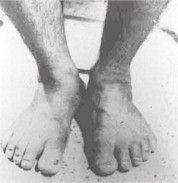
Figure 4. Congenital malformation of nail on right great toe of the Thai subject shown in Figure 3. This malformation
corresponded to a chronic ulcer of the right great toe from which the subject's uncle had suffered.

Figure 5. Small, round puckered birthmark on a Thai boy that corresponded to the bullet wound of entry in a man whose
life he said he remembered and who had been shot with a rifle from behind.
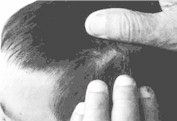
Figure 6. Larger, irregularly shaped birthmark on the frontal area of the head of the Thai boy shown in Figure 5. This
birthmark corresponded to the bullet wound of exit on the Thai man whose life the boy said he remembered.
Cases with Two or More Birthmarks
The argument of chance as accounting for the correspondence between birthmarks and wounds becomes much reduced when the child has two or more
birthmarks each corresponding to a wound on the deceased person whose life he claims to remember. Figure 3 shows a major abnormality of the skin
(verrucous epidermal nevus) on the back of the head of a Thai man who, as a child, recalled the life of his uncle, who had been struck on the head
with a heavy knife and killed almost instantly. The subject also had a deformed toenail of the right great toe (Figure 4). This corresponded to a
chronic infection of the same toe from which the subject's uncle had suffered for some years before he died.
The series includes 18 cases in which two birthmarks on a subject corresponded to gunshot wounds of entry and exit. In 14 of these one birthmark
was larger than the other, and in 9 of these 14 the evidence clearly showed that the smaller birthmark (usually round) corresponded to the wound of
entry and the larger one (usually irregular in shape) corresponded to the wound of exit.
These observations accord with the fact that bullet wounds of exit are nearly always larger than wounds of entry (Fatteh, 1976; Gordon and
Shapiro, 1982). Figure 5 shows a small round birthmark on the back of the head of a Thai boy, and Figure 6 shows a larger, irregularly shaped
birthmark at the front of his head.
The boy said that he remembered the life of a man who was shot in the head from behind. (The mode of death was verified, but no medical document
was obtainable.) In addition to the 9 cases I have investigated myself, Mills reported another case having the feature of a small round birthmark
(corresponding to the wound of entry) and a larger birthmark corresponding to the wound of exit (both verified by a postmortem report) (Mills,
1989).
I have calculated the odds against chance of two birthmarks correctly corresponding to two wounds. The surface area of the skin of the average
adult male is 1.6 meters (Spalteholz, 1943). If we were to imagine this area square and spread on a fiat surface, its dimensions would be
approximately 127 centimeters by 127 centimeters. Into this area would fit approximately 160 squares of the size 10 centimeters square that I
mentioned above.
The probability that a single birthmark on a person would correspond in location to a wound within the area of any of the 160 smaller squares is
only 1/160. However, the probability of correspondences between two birthmarks and two wounds would be (1/160)2 i.e. 1 in 25,600. (This calculation
assumes that birthmarks are uniformly distributed over all regions of the skin. This is incorrect [Pack, Lenson, and Gerber, 1952], but I believe the
variation can be ignored for the present purpose.)
Examples of Other Correspondences of Detail between Wounds and Birthmarks
A Thai woman had three separate linear hypopigmented scarlike birthmarks near the midline of her back; as a child she had remembered the life of a
woman who was killed when struck three times in the back with an ax. (Informants verified this mode of death, but no medical record was obtainable.) A
woman of Burma was born with two perfectly round birthmarks in her left chest; they slightly overlapped, and one was about half the size of the
other.
As a child she said that she remembered the life of a woman who was accidentally shot and killed with a shotgun. A responsible informant said the
shotgun cartridge had contained shot of two different sizes. (No medical record was obtainable in this case.)
Another Burmese child said that she remembered the life of her deceased aunt, who had died during surgery for congenital heart disease. This child
had a long, vertical linear hypopigmented birthmark close to the midline of her lower chest and upper abdomen; this birthmark corresponded to the
surgical incision for the repair of the aunt's heart. (I obtained a medical record in this case.)
In contrast, a child of Turkey had a horizontal linear birthmark across the right upper quadrant of his abdomen. It resembled the scar of a
surgeon's transverse abdominal incision. The child said that he remembered the life of his paternal grandfather, who had become jaundiced and was
operated on before he died. He may have had a cancer of the head of the pancreas, but I could not learn a precise medical diagnosis.
Two Burmese subjects remembered as children the lives of persons who had died after being bitten by venomous snakes, and the birthmarks of each
corresponded to therapeutic incisions made at the sites of the snakebites on the persons whose lives they remembered. Another Burmese subject also
said as a child that she remembered the life of a child who had been bitten on the foot by a snake and died.
In this case, however, the child's uncle had applied a burning cheroot to the site of the bite -- a folk remedy for snakebite in parts of Burma;
and the subject's birthmark was round and located at the site on the foot where the bitten child's uncle had applied the cheroot.
Three Examples of Birth Defects
Figure 8, below, shows the right side of the head of a Turkish boy with a diminished and malformed ear (unilateral microtia). He also had
underdevelopment of the right side of his face (hemifacial microsomia). He said that he remembered the life of a man who had been shot (with a
shotgun) at point-blank range. The wounded man was taken to a hospital where he died 6 days later -- of injuries to the brain caused by shot that had
penetrated the right side of the skull. (I obtained a copy of the hospital record.)

Figure 8. Severely malformed ear (microtia) in a Turkish boy who said that he remembered the life of a man who was fatally
wounded on the right side of the head by a shotgun discharged at close range.
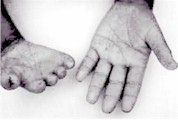
Figure 9. Almost absent fingers (brachydactyly) on one hand in a boy of India who said he remembered the life of a boy of
another village who had put his hand into the blades of a fodderchopping machine and had its fingers amputated.
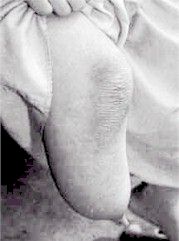
Figure 10. Small, round puckered birthmark on a Thai boy that corresponded to the bullet wound of entry in a man whose
life he said he remembered and who had been shot with a rifle from behind.
Figure 10. Small, round puckered birthmark on a Thai boy that corresponded to the bullet wound of entry in a man whose life he said he remembered
and who had been shot with a rifle from behind.
Figure 9 shows fingers almost absent congenitally on one hand (unilateral brachydactyly) in a child of India who said he remembered the life of
another child who had put his right hand into the blades of a fodder-chopping machine and lost his fingers.
Most cases of brachydactyly involve only a shortening of the middle phalanges. In the present case there were no phalangeal bones, and the fingers
were represented by mere stubs. Unilateral brachydactyly is exceedingly rare, and I have not found a published report of a case, although a colleague
(plastic surgeon) has shown me a photograph of one case that came under his care.
Figure 10 shows congenital absence of the lower right leg (unilateral hemimelia) in a Burmese girl. She said that she remembered the life of a
girl who was run over by a train. Eyewitnesses said that the train severed the girl's right leg first, before running over the trunk. Lower hemimelia
is an extremely rare condition, and Frantz and O'Rahilly (1961) found it in only 12 (4.0%) of 300 cases of all congenital skeletal deficiencies that
they examined.
DISCUSSION
Because most (but not all) of these cases develop among persons who believe in reincarnation, we should expect that the informants for the cases
would interpret them as examples according with their belief; and they usually do. It is necessary, however, for scientists to think of alternative
explanations.
The most obvious explanation of these cases attributes the birthmark or birth defect on the child to chance, and the reports of the child's
statements and unusual behavior then become a parental fiction intended to account for the birthmark (or birth defect) in terms of the culturally
accepted belief in reincarnation.
There are, however, important objections to this explanation. First, the parents (and other adults concerned in a case) have no need to invent and
narrate details of a previous life in order to explain their child's lesion. Believing in reincarnation, as most of them do, they are nearly always
content to attribute the lesion to some event of a previous life without searching for a particular life with matching details.
Second, the lives of the deceased persons figuring in the cases were of uneven quality both as to social status and commendable conduct. A few of
them provided models of heroism or some other enviable quality; but many of them lived in poverty or were otherwise unexemplary. Few parents would
impose an identification with such persons on their children.
Third, although in most cases the two families concerned were acquainted (or even related), I am confident that in at least 13 cases (among 210
carefully examined with regard to this matter) the two families concerned had never even heard about each other before the case developed.
The subject's family in these cases can have had no information with which to build up an imaginary previous life which, it later turned out,
closely matched a real one. In another 12 cases the child's parents had heard about the death of the person concerned, but had no knowledge of the
wounds on that person. Limitations of space for this article oblige me to ask readers to accept my appraisal of these 25 cases for this matter; but in
my forthcoming work I give a list of the cases from which readers can find the detailed reports of the cases and from reading them judge this
important question for themselves. Fourth, I think I have shown that chance is an improbable interpretation for the correspondences in location
between two or more birthmarks on the subject of a case and wounds on a deceased person.
Persons who reject the explanation of chance combined with a secondarily confected history may consider other interpretations that include
paranormal processes, but fall short of proposing a life after death. One of these supposes that the birthmark or birth defect occurs by chance and
the subject then by telepathy learns about a deceased person who had a similar lesion and develops an identification with that person. The children
subjects of these cases, however, never show paranormal powers of the magnitude required to explain the apparent memories in contexts outside of their
seeming memories.
Another explanation, which would leave less to chance in the production of the child's lesion, attributes it to a maternal impression on the part
of the child's mother. According to this idea, a pregnant woman, having a knowledge of the deceased person's wounds, might influence a gestating
embryo and fetus so that its form corresponded to the wounds on the deceased person.
The idea of maternal impressions, popular in preceding centuries and up to the first decades of this one, has fallen into disrepute. Until my own
recent article (Stevenson, 1992) there had been no review of series of cases since 1890 (Dabney, 1890); and cases are rarely published now (Williams
and Pembroke, 1988). Nevertheless, some of the published cases -- old and new -- show a remarkable correspondence between an unusual stimulus in the
mind of a pregnant woman and an unusual birthmark or birth defect in her later-born child.
Also, in an analysis of 113 published cases I found that the stimulus occurred to the mother in the first trimester in 80 cases (Stevenson,
1992). The first trimester is well known to be the one of greatest sensitivity of the embryo/fetus to recognized teratogens, such as thalidomide
(Nowack, 1965) and rubella (Hill, Doll, Galloway, and Hughes, 1958). Applied to the present cases, however, the theory of maternal impression has
obstacles as great as the normal explanation appears to have.
First, in the 25 cases mentioned above, the subject's mother, although she may have heard of the death of the concerned deceased person, had no
knowledge of that person's wounds. Second, this interpretation supposes that the mother not only modified the body of her unborn child with her
thoughts, but after the child's birth influenced it to make statements and show behavior that it otherwise would not have done. No motive for such
conduct can be discerned in most of the mothers (or fathers) of these subjects.
It is not my purpose to impose any interpretation of these cases on the readers of this article. Nor would I expect any reader to reach even a
preliminary conclusion from the short summaries of cases that the brevity of this report entails. Instead, I hope that I have stimulated readers to
examine the detailed reports of many cases that I am now in the process of publishing (Stevenson, forthcoming). "Originality and truth are found only
in the details" (Stendhal, 1926).
ACKNOWLEDGEMENTS
I am grateful to Drs. Antonia Mills and Emily W. Cook for critical comments on drafts of this paper. Thanks are also due to the Bernstein Brothers
Parapsychology and Health Foundation for the support of my research.
Correspondence and requests for reprints should be addressed to: Ian Stevenson, M.D., Division of Perceptual Studies, Box 152, Health Sciences
Center, University of Virginia, Charlottesville, VA 22908
ที่มา : http://www.near-death.com/experiences/reincarnation01.html
กลับชาติมาเกิดในประเทศจีน
Wednesday, 31. May 2006, 16:21:14
ณ ถู่เอ๋อฉีย่าต๋า มีเด็กชายคนหนึ่งอายุ 11 ปี ชื่อว่า "อีซื่อยี่" ชาติก่อนเขาคือ "อาปี่" ชายที่ถูกฆ่าตาย เพราะว่า เด็กน้อย "อีซื่อยี่"
สามารถจดจำเรื่องราวเมื่อชาติก่อนสมัยเป็นอาปี่ได้ทั้งหมด อีกทั้งไม่มีอะไรผิดพลาดเลยแม้แต่น้อย เมื่ออีซื่อยี่อายุได้ 1 ขวบครึ่ง
เขานอนอยู่กับพ่อของเขาบนเตียง
ทันใดนั้น อีซื่อยี่พูดออกมาเป็นเสียงผู้ใหญ่ว่า "ข้าไม่อยากอยู่ที่นี่อีกต่อไปแล้ว ข้าจะกลับไปอยู่กับลูกของข้า
พ่อของอีซื่อยี่ได้ยินเช่นนั้น ก็ตกใจ คิดว่าลูกของตนถูกผีเข้า เด็กตัวน้อยขนาดนี้ จะมีลูกของตัวเองได้อย่างไร ดังนั้น พ่อของอีซื่อยี่จึงกล่าวว่า
"อีซื่อยี่ ที่นี่คือบ้านของลูก แต่อีซื่อยี่กล่าวว่า "ข้าไม่ได้ชื่อ อีซื่อยี่ และที่นี่ก็ไม่ใช่บ้านของข้า ข้าคืออาปี่ที่ถูกฆ่าตาย เมื่อข้าอายุได้ 50
ปีถูกคนตีที่ศีรษะจนตาย
สิ่งที่อีซื่อยี่กล่าวออกมา ทำให้พ่อของเขารู้สึกมึนงง เขานำเรื่องนี้ไปเล่าให้ภรรยาฟัง ภรรยาของเขาฟังแล้วก็ตกใจ เพราะว่าเขาและภรรยานับถือศาสนาอิสลาม
พวกเขาไม่เชื่อในเรื่อง "การกลับชาติมาเกิด แต่เมื่อเขาเห็นปานดำบนศีรษะของอีซื่อยี่ พวกเขาก็เชื่อว่าเป็นรอยแผลซึ่งถูกตีที่ศีรษะเมื่อชาติก่อน
อาปี่ที่อีซื่อยี่พูดถึงนั้น เป็นเหตุการณ์ที่เกิดขึ้นก่อนที่อีซื่อยี่จะเกิดหลายเดือน เดือนมกราคม 1956 ที่หม่าจิ้วมีคนงานสวนผลไม้หลายคนถูกฆ่าตาย
เมื่อภรรยาและลูกๆ ของอาปี่ได้ยินเสียงร้องของอาปี่ พวกเขาก็รุดไปที่เกิดเหตุ หลังจากนั้นประมาณ 1 สัปดาห์ฆาตกรก็ถูกจับได้
บ้านของอาปี่อยู่ด้วยภรรยาของเขา บุตรสาวและบุตรชาย
ข้าต้องกลับไปอยู่กับลูก อีซื่อยี่กล่าวกับพ่อแม่ของเขาอีกครั้ง
เด็กคนนี้บ้าไปแล้ว พ่อแม่ของเขารู้สึกเสียใจ
ตั้งแต่นั้นเป็นต้นมา ทุกครั้งที่พ่อแม่เขาเรียก "อีซื่อยี่ อีซื่อยี่ เขาจะไม่ยอมขานตอบ แต่ถ้าเรียกเขาว่า "อาปี่ เขาจะรีบขานทันที
ทำให้พ่อแม่ของเขาไม่รู้ว่าจะทำอย่างไรดี
บางครั้ง ขณะที่นอนหลับอยู่ อีซื่อยี่ก็ละเมอขึ้นมาว่า "ลูก อย่าร้องนะ ลักษณะและน้ำเสียงพูดนั้นเหมือนพ่อกำลังปลอบลูก เวลาผ่านไป 1 ปี วันหนึ่ง
พ่อของอีซื่อยี่ซื้อแตงโมกลับมาบ้านเพื่อแบ่งกินกัน อีซื่อยี่รีบคว้าลูกที่ใหญ่ที่สุดไวพร้อบกับกล่าวว่า
"แตงโมลูกนี้ใครก็กินไม่ได้ ต้องเหลือไว้ให้ลูกของข้า พี่น้องทั้งเก้าคนของอีซื่อยี่ก็โวยวาย พ่อของเขาต้องรีบมาจัดการ
อีซื่อยี่เสียใจมากจนร้องไห้ออกมา
อาปี่ชาติก่อนเป็นนักเลงเหล้า ปกติจะชอบดื่มเหล้ามาก อีซื่อยี่ก็มักจะแอบพ่อแม่ดื่มเหล้าบ่อยๆ มีครั้งหนึ่ง ขณะที่เขากำลังขโมยดื่มเหล้าอยู่นั้น
ก็ถูกอามาเจอเข้า จึงถูกอบรมสั่งสอนเสียพักใหญ่ อีซื่อยี่ไม่เพียงแต่ไม่สนใจ กลับกล่าวอย่างแข็งกระด้างว่า
"เด็กน้อย เรื่องเล็กๆ น้อยๆ แค่นี้ เชอะ เจ้ากล้ามาด่าข้าว่าขโมยเหล้ากินหรือ เจ้ายังจำได้ไหม ที่สวนผลไม้เจ้าขโมยเหล้าข้ากิน ถูกข้าจับได้
แต่ข้าก็ไม่ได้ว่าอะไรเจ้า คิดไม่ถึงมาวันนี้เจ้ามาลืมบุญคุณข้าเสียแล้ว ยังกล้ามาด่าข้าอีก ช่างเลวจริงๆ อาเมื่อถูกหลานด่าว่าเช่นนี้
ถึงกับพูดอะไรไม่ออก
อีซื่อยี่ไม่เพียงแต่รู้เรื่องราวเมื่อชาติก่อนของอาปี่เท่านั้น ยังสามารถรู้จักคนที่ไม่เคยเห็นหน้ามาก่อนอีกด้วย มีครั้งหนึ่ง
พ่อของเขาเป็นพ่อค้าขายเนื้อกำลังแล่เนื้ออยู่ อีซื่อยี่เข้ามายืนข้างๆ ขอร้องพ่อเขาว่า "หลังจากที่ย่างเนื้อก้อนนี้แล้ว
นำไปที่บ้านของข้าให้ลูกข้าได้กิน
เด็กบ้านี่ พูดอะไรอยู่ได้ แกไม่ใช่ อาปี่อะไรหรอก คราวหน้าถ้าพูดอะไรแบบนี้อีก ข้าจะตีแกให้หนักเชียว
ยังมีอีกครั้งหนึ่ง คนขายไอศกรีมคนหนึ่งมา อีซื่อยี่ไม่เคยเห็นเขามาก่อน แต่อีซื่อยี่เดินเข้าไปทักทายเขา "เฮ้อ เจ้ายังรู้จักข้าไหม?
คนขายไอศกรีม เห็นเป็นเด็กน้อย มาทักทายตน ได้แต่ส่ายศีรษะกล่าวว่า
"ข้าไม่รู้จักเจ้าหรอก เจ้าเด็กน้อย อีซื่อยี่ใช้มือชี้ที่จมูกตนเองกล่าวว่า "เจ้าลืมได้อย่างไร? เจ้าไม่รู้จักข้าจริงๆ หรือ?
คนขายไอศกรีม มองอีซื่อยี่เป็นเวลานาน ในที่สุด ก็ส่ายศีรษะ ข้าคืออาปี่ เมื่อก่อนเจ้าเป็นคนขายผักผลไม้ไม่ใช่หรือ? เปลี่ยนอาชีพตั้งแต่เมื่อไหร่?
จำได้เมื่อตอนเจ้ายังเป็นเด็กอยู่ ข้ายังทำพิธีสุหนัด (การคลิบปลายอวัยวะเพศชาย) ให้กับเจ้าเลย สิ่งที่อีซื่อยี่กล่าวมาทั้งหมดนั้นล้วนเป็นเรื่องจริง
ภายหลังที่เหตุการณ์นี้เกิดขึ้น ข่าวการ "กลับชาติมาเกิดของอาปี่ แพร่ออกไปทุกที่
อีซื่อยี่เพื่อพิสูจน์เรื่องนี้ ก็ไปที่บ้านของอาปี่ซึ่งอยู่ห่างออกไปจากบ้านของเขาประมาณ 1 กิโลเมตร อีซื่อยี่ไม่เคยมาที่นี่ก่อนเลย แต่ว่า
แต่เขากลับเดินนำหน้า ผู้ร่วมทางบางคนแกล้งชี้ทางผิดให้ อีซื่อยี่ก็ไม่สนใจ เขายังคงมุ่งหน้าไปบ้านของอาปี่
บ้านของอาปี่มีผู้หญิงวัยกลางคนคนหนึ่ง เมื่ออี่ซื่อยี่เห็นเธอ เขารีบวิ่งเข้าไปกอดหล่อน "อา! เซี่ยตี้ซือ กล่าวจบแล้วก็ถามถึงลูกๆ ของอาปี่
หลังจากนั้นก็นำผู้ร่วมทางมายังที่หม่าจิ้ว ชี้จุดหนึ่งของหม่าจิ้ว แล้วก็กล่าวอย่างเจ็บปวดว่า "ข้าถูกลาลั่วซาง (ชื่อของฆาตรกร) ฆ่าตายที่นี่
ผู้ร่วมทางฟังแล้วก็รู้สึกแปลกประหลาดเป็นอย่างมาก
อีซื่อยี่ยังเดินต่อไปยังหลุมฝังศพ หลุมฝังศพของอาปี่ไม่มีป้ายชื่อใดๆ ที่แสดงเป็นพิเศษ แต่อีซื่อยี่กลับรู้ได้ อีซื่อยี่เดินไปที่หน้าหลุมฝังศพ
ชี้และกล่าวว่า "ที่นี่เป็นศพฝังศพของข้าเมื่อชาติก่อน
เขาเดินต่อไปยังสวนผลไม้ คนงานกำลังทำงานอยู่หลายคน อีซื่อยี่ไม่เพียงแต่พูดชื่อของพวกเขาออกมาทีละคน
ยังสามารถบอกได้ว่าแต่ละคนมาจากที่ไหนบ้างโดยไม่ผิดเลยแม้แต่คนเดียว
อีซื่อยี่เป็นอาปี่กลับชาติมาเกิดจริงๆ ทุกคนต่างกล่าวเป็นเสียงเดียวกัน แต่พ่อแม่ของอีซื่อยี่ก็กังวลใจและกลัวว่า
ลูกของเขาจะเอาเขาไปอยู่ที่บ้านของอาปี่
เรื่องการกลับชาติมาเกิดนี้แพร่หลายออกไปทั่วโลก ปี 1962 เมื่อ "อีซื่อยี่" อายุได้ 6 ขวบ "อาจารย์มหาวิทยาลัยลาฉาซือ" อินเดีย ดร. H.N.
ปาน่าเอ๋อจี๋ (นักจิตวิทยา) เดินทางไปพบเขาและศึกษาการกลับชาติมาเกิดของอาปี่ --- อีซื่อยี่ เขาต้องการตรวจสอบความเป็นจริงเกี่ยวกับเรื่องนี้
เพื่อนของ ดร. ปาน่าเอ๋อจี๋ เป็นนักจิตวิทยาชาวญี่ปุ่น ก็มาพิสูจน์เรื่องนี้เช่นกันและกล่าวว่า "ปาน่าเอ๋อจี๋เป็นนักวิทยาศาสตร์
จึงใช้วิธีการทางวิทยาศาสตร์มาพิสูจน์เรื่องนี้ว่าเป็นเรื่องจริงหรือไม่ หรือว่าเป็นเพียงเรื่องแหกตาเพื่อหาเงินเท่านั้น เราได้ทดสอบข้อสงสัยทุก ๆ
ข้อที่เกิดขึ้น ในที่สุดก็สรุปได้ว่า การกลับชาติมาเกิดของอาปี่ มาเป็นอีซื่อยี่นั้น เป็นเรื่องจริง
แปลและเรียบเรียงจากเรื่อง "ฉวนเซิงฉีจี้ ของ "หยูหลิง
http://my.opera.com/dosgames/blog/show.dml/278573
|
|
|
|
Posts: 2052 |
Registered: 8/1/08 |
Member Is Offline |
|
|
|
![[*]](./images/corporate/default_icon.gif) posted on 13/9/08 at 15:33 posted on 13/9/08 at 15:33 |

|
เด็กหญิงสำเนียง ผู้ระลึกชาติได้ในประเทศไทย
เด็กหญิงสำเนียงกลับชาติมาเกิดใหม่ เธอคือ ปรานี ( น้อย ) สีเทา ณ ที่บ้านคอนสวรรค์ จังหวัดสุรินทร์
เดือนเมษายน พ.ศ. ๒๕๐๓
นายเที่ยง - นางเพชร สว่างผุย ได้ให้กำเนิดบุตรสาวคนแรก ตั้งชื่อว่า สำเนียง ในปี พ.ศ. ๒๕๓๕ นายเที่ยง มีอายุได้ ๕๕ ปี นางเพชร
มีอายุได้ ๕๓ ปี มีบุตรด้วยกันรวม ๘ คน ดังนี้
๑. เด็กหญิงสำเนียง ตายตั้งแต่อายุ ๘ ขวบ
๒. เด็กชายเจียงลม ตายตั้งแต่อายุ ๖ เดือน
๓.นางสำรอง
๔.นางสำลี
๕.นายสมพร
๖.นายละคร
๗.นางสาวไกรสร
๘. เด็กหญิงบังอร
ต้นเดือนกุมภาพันธ์ พ.ศ. ๒๕๑๐ สำเนียงมีอายุได้ ๘ ขวบ กำลังจะเข้าโรงเรียนในเดือนพฤษภาคม พ่อแม่ก็ได้ซื้อเครื่องแบบนักเรียนมาไว้ให้
เพื่อจะได้ใส่ไปโรงเรียน แต่ในบ่ายวันหนึ่ง มีคนขึ้นเอาลูกตาลอ่อน ที่อยู่ใกล้บ้านทางทิศใต้ ( เดี๋ยวนี้ยังอยู่ ) สำเนียงได้เก็บเอาลูกตาลมาหอบหนึ่ง
เอามาให้แม่ปอกให้กิน
ตกตอนกลางคืน เวลาประมาณตี ๑ ตี ๒ สำเนียงเกิดปวดท้องอย่างหนัก มีอาการเจ็บแน่นขึ้นเรื่อย ๆ พ่อกับแม่ได้หายาพื้นบ้านมาให้กินแต่ก็ไม่หาย
จนรุ่งสว่างก็ไม่ทุเลาสำเนียงได้บอกแม่ว่า ถ้าเจ็บอย่างนี้ตนคงไม่รอดแน่ และในที่สุดสำเนียงก็ทนไม่ได้ สิ้นใจไปในเช้าวันนั้นเอง
พอเวลาบ่ายก็เอาศพของสำเนียงไปฝังไว้ที่ป่าช้า ทางทิศตะวันตกของบ้านคอนสวรรค์ ก่อนเอาศพสำเนียงลงโลงนั้น
แม่ได้เอาขมิ้นผสมปูนป้ายไว้ที่หน้าอกของสำเนียงด้วย โดยคิดว่าหากลูกเกิดมาอีกจะได้มีเครื่องหมายบอกไว้ให้รู้ และเมื่อจะเอาศพของสำเนียงไปฝังนั้น
ศพยังไม่เย็นไม่แข็งเลย ยังมีความอุ่นอยู่เหมือนคนยังไม่ตาย จนบางคนว่าอย่าเพิ่งเอาไปฝัง เพราะบางทีสำเนียงอาจจะฟื้นมาอีก เพราะกายยังอุ่น ๆ อยู่
แต่บางคนก็แย้งว่า ตายไปแล้วไม่มีทางฟื้นหรอก ที่ยังอุ่นอยู่นั้นก็เพราะตายสด ๆ ไม่ได้เจ็บป่วยเป็นเวลานานจึงเป็นเช่นนี้ ในที่สุด
ก็เอาศพของสำเนียงไปฝังในบ่ายวันนั้นเอง วันนั้น เมื่อจัดการฝังศพเสร็จ ตอนเดินทางหลับ นายเที่ยงซึ่งเป็นพ่อของสำเนียง
ได้เห็นนกเค้าตัวหนึ่งติดหนามเล็บแมวอยู่ นายเที่ยงก็ปลดออนำนกเค้าตัวนั้นมาปล่อยไว้ที่วัดบ้านคอนสวรรค์
วันรุ่งขึ้นตอนเข้า นายเที่ยงออกไปทุ่งนา ก็ไปเจอนกเค้าตัวนั้นอีก ยืนขวางทางอยู่ เขาสังหรณ์ใจว่า หรือเป็นลูกเรามาเยี่ยมกระมัง
แล้วก็อุ้มนกเค้ามาปล่อยที่วัดอีก แล้วต่อจากนั้นมา ก็ไม่พบนกเค้าตัวนั้นอีกเลย
ต่อมาเช้าวันหนึ่ง ที่บ้านนายเที่ยง นางเพชร ขณะที่หลายคนกำลังนั่งผิงไฟกันอยู่ ( เพราะเป็นเดือน ๓ ฤดูหนาว )
มีหลายคนได้เห็นหนูตัวใหญ่วิ่งเข้าไปในผ้าซิ่นที่นางเพชรนุ่งอยู่ หลายคนก็ร้องว่า หนูเข้าซิ่น ๆ จับเอา ๆ
นางเพชรก็ตะครุบโน่น ตะครุบนี่ ตามที่เขาบอกแต่ก็ไม่พบหนูสักตัว ก็ได้แค่พากันคิดว่า สำเนียงมาหาแม่ ต่อจากนั้น เหตุการณ์ที่บ้านนายเที่ยง นางเพชร
ก็เป็นปกติดังเดิม เวลาล่วงมาถึงปี พ.ศ. ๒๕๑๑ นับจากเวลาที่สำเนียงถึงแก่กรรมได้ ๑ ปี
ณ ที่บ้านช่อง จังหวัดสุรินทร์ ซึ่งบ้านช่องนี้อยู่ทางทิศใต้ของบ้านคอนสวรรค์ ท่างกันประมาณ ๓ กิโลเมตรเศษ เจ้าของบ้านคือ นายสาย - นางเทื่อม สีเทา
ซึ่งเป็นผัวหนุ่มเมียสาว และได้ให้กำหนิดบุตรสาวคนเเรก เมื่อวันที่ ๒๘ กุมภาพันธ์ พ.ศ. ๒๕๑๑ พ่อแม่ตั้งชื่อให้ว่า ปรานี
มีชื่อเล่นว่า น้อย
น้อยเป็นเด็กผิวขาว น่ารัก เมื่อน้อยอายุได้ ๑๐ ขวบ ยายมลซึ่งเป็นยายของน้อยก็เอาน้อยไปอยู่ด้วย เพราะที่บ้านยายไม่มีเด็กเลย ดังนั้น
ความสนิทนสนมระหว่างน้อยกับยาย จึงมีมากว่าทางแม่เทื่อม เป็นอย่างมาก
พอน้อยอายุได้ ๓-๔ ขวบ กำลังช่างพูดนั้น วันหนึ่งน้อยได้บอกยายว่า ในชาติก่อนเธอเกิดที่บ้านคอนสวรรค์เป็นลูกของแม่เพชร มีชื่อว่าสำเนียง เมื่ออายุได้ ๘
ขวบ เธอปวดท้องจนตาย แล้วได้มาเกิดเป็นลูกแม่เทื่อม ที่บ้านช่อง เมื่อยายได้ฟังนั้น ก็ตะคอกไปว่า
อีนังบ้า พูดอะไรอย่างนั้น แม่ที่คอนสวรรค์ที่ไหนจะมี ก็แม่เทื่อมนี่แหละเป็นแม่ของเอ็ง
น้อยก็เถียงยายว่า เธอพูดจริง ๆ ไม่ได้เป็นบ้าอะไรเลย ถึงกับท้าจะพายายไปดูหลุมศพ แต่ยายไม่กล้าไป เมื่อยายเห็นว่าน้อยจะพูดมากไปแล้ว ก็ขู่ว่า
ต่อไปนี้ห้ามพูดอย่างนี้ ถ้าพูดอีกยายจะตี และจะ ไม่รักน้อยอีก น้อยก็กลัวยายตี และกลัวยายจะไม่รักตน ก็เงียบไปชั่วระยะหนึ่ง
ต่อมาไม่นาน น้อยก็พูดเรื่องชาติก่อนอีกก็ถูกยายตวาดเอาอีก เมื่อนำเรื่องนี้มาพูดให้พ่อสาย แม่เทื่อมฟังก็ถูกด่าเอาอีก น้อยก็ต้องนิ่งเงียบไปอีก
ในบางครั้ง น้อยก็ขอให้ยายพาไปหาแม่ที่บ้านคอนสวรรค์ น้อยบอกว่าญาติพี่น้องคอนสวรรค์นั้นเขารู้หมดว่าบ้านใครอยู่ตรงไหน หน้าตาเป็นอย่างไร แต่จำชื่อไม่ได้
แม้แต่พ่อเดิมที่บ้านคอนสวรรค์ก็จำชื่อไม่ได้ แต่จำรูปร่างหน้าตาได้ คงจำชื่อได้เฉพาะแม่เพชรเท่านั้น คนโบราณเขาเชื่อกันว่า ถ้าปล่อยให้ระลึกชาติได้
พูดถึงเรื่องของตนในชาติก่อนแล้ว คนนั้นจะเกิดความเจ็บป่วย ดังนั้น ยายและพ่อกับแม่ของน้อย จึงไม่ยอมให้น้อยพูดเรื่องชาติก่อนเด็ดขาด
ยายได้พาน้อยไปให้หลวงพ่อรดน้ำมนต์ให้ถึง ๗ วัด เพื่อให้น้อยลืมเรื่องชาติก่อนของตน แต่น้อยก็ไม่ลืมง่าย ๆ น้อยเคยบอกยายว่า พ่อแม่ที่แท้จริงของเธอนั้น
คือ พ่อเที่ยง แม่เพชร อยู่บ้านคอนสวรรค์ ส่วนพ่อสาย แม่เทื่อม ที่อยู่บ้านช่องนั้น น้อยมาอาศัยท้องเกิดเท่านั้น เป็นที่น่าสังเกตุว่า ลูกของแม่เทื่อม
พ่อสายนั้น ทุกคนมีผิวค่อนข้างดำแดงกันทุกคน มีผิวขาวคนเดียวเท่านั้น คือน้อย
ส่วนลูกของแม่เพชร พ่อเที่ยงนั้น ทุกคนมีผิวค่อนข้างขาวทั้งนั้น และที่น่าพิศวงสงสัยอีกอย่างก็คือ ตรงบริเวณเหนือนมข้างซ้ายของน้อยจะมีปานสีแดง
ขนาดเท่าหัวไม้ขดไฟ ฝังอยู่ลึก ๆ พอมองเห็นได้ชัดเจน แม่เพชรบอกว่า รูปร่างหน้าตาของน้อยและของสำเนียงที่ตายไปแล้ว เหมือนกันมาก
ถามคนข้างบ้านเขาก็บอกว่าอย่างนั้น
ครั้งหนึ่ง เมื่อน้อยอายุได้ประมาณ ๖ ขวบ เห็นแม่เทื่อมตีน้อง น้อยโมโหแม่สุดขีด ได้พูดไปว่า
ลูกตัวเองซึ่งเลี้ยงมาแท้ ๆ ยังตีได้ ช่างไม่สงสารเสียเลย น้อยไม่ได้เลี้ยงมา น้อยยังสงสาร แล้วน้อยก็เอาไม้กวาดตีแม่จนหัวแตก น้อยบอกว่า
ความอยากไปหาแม่ที่บ้านคอนสวรรค์นั้นไม่เคยเบาบางเลย ให้ใครพาไปเขาก็ไม่พาไป จะไปคนเดียวก็กลัว
ครั้งหนึ่ง มีคนบ้านคอนสวรรค์มาทำธุระที่บ้านช่อง ตอนขากลับได้เดินผ่านหน้าบ้านของน้อย น้อยมองเห็นก็รู้ทันทีว่า หญิงคนนั้นอยู่บ้านคอนสวรรค์
แต่ไม่รู้จักชื่อ น้อยได้วิ่งตามไปติด ๆ ปากก็ร้องว่า ป้าจ๋า ๆ น้อยขอไปหาแม่ที่บ้านคอนสวรรค์ด้วยนะ
ยายมลต้องวิ่งตามเอาตัวน้อยมาจนเหนื่อยอ่อน ตอนนั้นน้อยบอกว่าน้อยใจมาก ที่ยายดึงเอาตัวกลับมา ไม่ได้ไปหาแม่ที่บ้านคอนสวรรค์
จึงประท้วงยายด้วยการอดอาหารถึง ๓ วัน
ต่อจากนั้นมา ยายมลจะพยายามไม่ให้น้อยได้พบกับคนในบ้านคอนสวรรค์อีกเลย เพราะกลัวน้อยจะไปกับเขาเหล่านั้น ข้าพเจ้าเคยถามน้อยว่า
เมื่อตายแล้ววิญญาณไปอยู่ที่ไหน อยู่กับใคร กินนอนอย่างไร
น้อยบอกว่า เมื่อตายแล้ว ได้ไปอยู่กับเพื่อน ๆ หลายคน มีทั้งเด็กและผู้ใหญ่ ที่อยู่นั้นเป็นบ้างหลังแคบ ๆ แต่สูงชะลูด มีบันไดเล็ก ๆ ลักษณะเป็นเกล็ด
ๆ พาดขึ้นไป รู้สึกว่าบ้านดังกล่าวอยู่ใกล้ ๆ สะพานข้ามห้วย ทางทิศใต้ของหมู่บ้าน
ข้าพเจ้านึกออกทันทีว่าที่นั้นคือ ต้นพอกใหญ่ตรงหัวสะพานแน่นอน ( เดี๋ยวนี้เขาโค่นลงแล้ว) น้อยบอกว่าไม่ค่อยอยู่เป็นที่ เพราะเพื่อน ๆ มาชวนไปโน่นบ้าง
นี่บ้าง อาหารก็ได้กินบ้าง ไม่ได้กินบ้าง รู้สึกว่าตนมีความหิวอยู่ตลอดเวลา ข้าพเจ้าถามน้อยว่า
อยู่นานเท่าไหร่จึงได้มาเกิดใหม่ น้อยบอกว่า ที่โลกวิญญาณนั้น ไม่มีกลางวันกลางคืน ไม่เห็นดวงดาวเลย แต่มืดมาก ไม่สว่างมาก พอสลัว ๆ เท่านั้น
แต่ในความคิดของน้อยนั้น คิดว่าอยู่ ๓ วัน ก็มาเกิดใหม่
ข้าพเจ้าถามว่า ตอนเกิดใหม่นั้น มาอย่างไร น้อยตอบว่า ทีแรกนั้นอยากมาเกิดกับแม่เพชร ได้เคยแปลงกายเป็นนกเค้า และเป็นหนู มาหาแม่
แต่เห็นแม่กำลังมีน้องอยู่ในท้อง ก็มาเกิดไม่ได้ เลยคิดหาทางมาเกิดกับแม่ใหม่ต่อไป
ในตอนที่อยู่ในโลกวิญญาณนั้น น้อยบอกว่าพวกเพื่อน ๆ มักจะพาไปกินอาหารในบ้านที่เขามีการทำบุญแจกข้าวอยู่เสมอ ถ้าบ้านใดยังมีศพอยู่ในบ้าน
พอเขายกอาหารมาเลี้ยงแขก แขกยังไม่ทันกินเลย พวกวิญญาณทั้งหลายต่างก็แย่งกันเข้าไปกินเสียก่อน มองดูตั้งร้อยมือพันมือ ต่างยื้อแย่งเอาอาหารมากิน มือดำ ๆ
ด่าง ๆ เหี่ยว ๆ ย่น ๆ และมีน้ำเหลืองเยิ้มอยู่ก็มี
น้อยยืนดูแล้วรู้สึกสะอิดสะอียน แทบจะอาเจียนเสียให้ได้ เลยไม่ได้เข้าไปกินกับเขา ยอมอดเอาดีกว่า ถ้างานใดไม่มีศพอยู่ในบ้าน
พวกวิญญาณเหล่านั้นก็ไม่ไปแย่งกันกิน ต่อเมื่อพระท่านฉันเสร็จ มีคนเรียกให้กินนั้นแหละ พวกเขาจึงกล้าเข้าไปกิน
แม้ทุกวันนี้ งานศพใดก็ดี ถ้าศพยังอยู่ในบ้าน น้อยจะไม่กล้ากินอาหารที่บ้านนั้นเลย และถ้าขืนกินเข้าไป ก็จะอาเจียนออกมาทันที ได้ถามน้อยว่า
ตอนมาเกิดกับแม่เทื่อมนั้น มาอย่างไร
น้อยตอบว่า ตอนนั้นเห็นแม่เทื่อมหาบตะกร้ามาจากใกล้ ๆ แม่เทื่อมก็วางหาบไว้แล้วเข้าไปวักน้ำในบ่อดื่ม พอเห็นแม่เทื่อม ก็นึกอยากจะเกิดด้วยทันที
ดังนั้นพอแม่เทื่อมยกหาบขึ้นบ่า วิญญาณของน้อยก็กระโดดขึ้นนั่งบนไม้คาน มาบ้านกับแม่เทื่อมทันที มาถึงบ้านแม่เทื่อมวางหาบลงแล้ว ก็เดินไปตักน้ำในตุ่มดื่ม
น้อยได้โอกาสก็กระโดดเข้าไปในขัน แล้วลงสู่ท้องแม่เทื่อมในบัดนั้น
ต่อมาได้ถามแม่เทื่อมถึงการตั้งท้องลูกคนแรก แม่เทื่อมก็บอกว่ารู้สึกว่าได้ตั้งท้องในเดือนที่กลับจากบ้านคอนสวรรค์นั้นเอง ล่วงมาอีกประมาณ ๑๐ เดือน
แม่เทื่อมก็ให้กำเนิดบุตรสาวคนเเรก เมื่อวันที่ ๒๘ กุมภาพันธ์ พ.ศ. ๒๕๑๑ บุตรสาวคนนั้นก็คือ ปราณี หรือ "น้อย" นั้นเอง
น้อยเล่าให้ฟังว่า เธอมักมีปรากฏการณ์แปลกเกิดขึ้นอยู่เสมอ เป็นต้นว่า ถ้านอนกลางวัน พอเคลิ้ม ๆ จะหลับในบางครั้ง เธอจะพบว่า เธอมีสองร่าง
ร่างหนึ่งนอนอยู่ อีกร่างหนึ่งนั่งดูร่างที่นอน เธอก็เกิดสงสัยว่า ทำไมเรามีสองร่าง หรือว่าวิญญาณของเราออกจากร่าง ถ้าเป็นจริงแล้ว
หากวิญญาณเราไม่กลับเข้าร่าง เราคงตายแน่
เมื่อคิดดังนี้ เธอก็เกิดกลัวตายขึ้นมา และคิดไปว่าเราจะต้องคืนเข้าร่างเดิมเดี๋ยวนี้ พอคิดปุ๊ป ร่างที่นั่งอยู่ก็จะกลัววูบเข้าร่างเดิมทันที
แล้วเธอก็สะดุ้งตืนขึ้นมา ในบางวันเธออยู่คนเดียวเงียบ ๆ จะปรากฏเป็นภาพชีวิตของเธอ แต่ชาติก่อนเด่นชัดลอยมาให้เห็นเหมือนดูภาพยนต์
เมื่อฉากนี้ผ่านไปฉากใหม่ก็เลื่อนเข้ามาแทนแล้วก็เลื่อนหายไปในที่สุด
ยายของน้อยถึงแก่กรรมไปเมื่อปี พ.ศ. ๒๕๑๘ ตอนนั้นน้อยอายุได้ ๘-๙ ขวบ เมื่อยายตายจากไปแล้ว น้อยได้มาอาศัยอยู่กับพ่อสายแม่เทื่อมจนกระทั่งทุกวันนี้
เมื่อยายจากไปแล้ว น้อยมักจะฝันเห็นยายบ่อย ๆ ในบางคืนเวลานอนหลับ น้อยก็ถูกผีอำ คือมีคนมานอนทับทำให้ตัวแข็งเคลื่อนไหวไม่ได้ ไม่ทราบจะแก้ไขอย่างไร
เมื่อน้อยมีอายุได้ ๑๘ ปี ในปี พ.ศ. ๒๕๒๙ น้อยได้ไปทำงานรับจ้างอยู่ที่จังหวัดชลบุรี วันหนึ่งเธอเดินผ่านวัดกำแพงเป็นเวลาที่พระท่านกำลังเทศน์
ตอนหนึ่งพระท่านเทศน์ว่า การทำบุญอุทิศส่วนกุศลไปให้ญาติผู้ตายไปแล้วนั้น ผู้ตายต้องได้รับแน่ถ้าทำถูกวิธี กล่าวคือ ต้องทำบุญกับพระสงฆ์องค์เจ้าผู้มีศีล
มีการกรวดน้ำอุทิศส่วนกุศลให้ผู้ตายและขณะที่กรวดน้ำต้องออกชื่อของผู้ตาย ให้เข้ามารับเอาส่วนกุศลนั้นด้วย ทำอย่างนี้ผู้ตายจะได้รับส่วนกุศลแน่นอน
อีกประการหนึ่ง ถ้าอยากให้ผู้ตายได้รับส่วนกุศลสูงยิ่งขึ้นไป ก็คือการบวช และอุทิศส่วนกุศลไปให้อันนี้มีกุศลสูงกว่าวัตถุทานธรรมดา
เมื่อน้อยได้ฟังพระเทศน์ดังนี้ ก็บังเกิดความคิดขึ้นมาทันทีว่า เราจะลองดู เราจะบวชอุทิศให้ยายของเราดู เพราะการที่ยายมาเข้าฝันเราบ่อย ๆ นั้น
ยายคงจะอยากได้ส่วนกุศลจากเรา ตกลงคืนนั้น น้อยนอนไม่หลับเลย คิดอยากจะบวชอย่างเดียว คิดอยู่แต่ว่า เมื่อไรหนอจะสว่าง เราจะได้กลับบ้านไปบวชให้ยาย (
ยายไม่มีลูกชายเลย ) สักคนเดียว
รุ่งเช้าวันใหม่ น้อยก็กลับมาบ้านอย่างรีบร้อน โดยไม่ได้รอรับเงินเดือนเสียก่อน
เมื่อมาถึงบ้านก็ปรึกษาเรื่องบวชชีกับพ่อแม่ พ่อแม่ก็เห็นด้วย แต่เผอิญตอนนั้นแม่เทื่อมกำลังป่วย มีอาการอ่อนเปลี้ยเสียขา
เดินไม่ได้รักษากับหมอก็ไม่หาย น้อยจึงคิดสังหรณ์ในใจ แล้วพูดกับแม่ว่า ถ้าหากยายมาทำให้แม่เจ็บป่วยอย่างนี้ ก็ขอให้หายเสียเถอะ ถ้าหายแล้วน้อยจะบวชให้ยาย
น่ามหัศจรรย์เหลือเกิน อยู่ต่อมาอีก ๒ ๓ วันเท่านั้น แม่เทื่อมก็หายเป็นปกติ เดินได้ดังเดิมทุกประการ เมื่อแม่เทื่อมหายป่วยแล้ว
พ่อสายก็พาน้อยกลับมาชลบุรีอีก เพื่อมาเอาเงินเดือนที่ยังไม่ได้รับไป
วันหนึ่งที่ชลบุรี พ่อสายกับน้อยพากันไปตลาด เพื่อซื้อของกลับบ้าน เดินผ่านไปทางวัดกลาง พ่อสายได้เดินเห็นป้ายคติเตือนใจ ที่ทางวัดทำเอาไว้รอบกำเเพงวัด
มีมากมายหลายป้าย มีป้ายที่มีข้อความสะกิดใจของพ่อสายอยู่ ๒ -๓ ป้าย คือที่เขียนว่า บาปบุญนั้นมีจริง นรกสวรรค์มีจริง และ คนตายแล้วเกิดใหม่ได้
พ่อสายอ่านแล้วก็พูดขึ้นว่า
คนตายแล้วจะเกิดใหม่ได้จริงหรือ ไม่เคยเห็นใครตายแล้วเกิดใหม่สักที มีแต่ตายแล้วสูญไปเลย น้อยก็พูดแย้งขึ้นทันทีว่า เกิดได้สิพ่อ
หนูนี่แหละที่ตายมาแล้วเกิดมาใหม่ได้ ได้เคยบอกหลายครั้งแล้ว พ่อก็ไม่เชื่อ พ่อสายก็ว่า หรือจะจริงของเอ็ง
จากวันที่ได้อ่านคติเตือนใจกับพ่อวันนั้นแล้ว ทำให้น้อยมีความคิดอยากจะพบแม่เพชรในชาติก่อนมากขึ้น และคืนก่อนที่จะกลับจากชลบุรีนั้น น้อยได้ฝันว่า
มีป้าคนหนึ่งที่อยู่บ้านคอนสวรรค์ จำชื่อไม่ได้ แต่จำหน้าได้อย่างแม่นยำ ไปเข้าฝันบอกน้อยว่า
น้อยเอ้ย .... อย่าได้คิดอะไรให้มันวุ่นวายใจไปมากเลย ถ้าเอ็งอยากพบแม่ในชาติก่อน ก็ไปพบเขาซิ แม่ชื่อเพชร พ่อชื่อเที่ยง อยู่บ้านคอนสวรรค์นั้นแหละ
พอน้อยสะดุ้งตื่นก็สว่างพอดี ความคิดอยากจะพบแม่ก็ยิ่งทวีขึ้น พอตกตอนค่ำก็รีบกลับบ้านช่องพร้อมกับพ่อสาย ขึ้นรถทัวร์ที่ตลาดหมอชิต เวลาประมาณ ๑ ทุ่ม
ถึงรัตนบุรีก็ประมาณตี ๕ ของวันใหม่ พอถึงบ้านก็ไม่ยอมหักเลยวางกระเป๋าแล้วก็เคี่ยวเข็ญพ่อสาย ให้พาไปหาแม่เพชรที่บ้านคอนสวรรค์ทันที
พอไปถึงบ้านคอนสวรรค์ เข้าไปในหมู่บ้าน น้อยก็เป็นคนคอยบอกว่าให้ไปทางโน้นทางนี้ พอขึ้นรถเครื่องผ่าน หน้าบ้านของพ่อเที่ยง แม่เพชร
น้อยก็บอกให้พ่อชะลอรถ แล้วมองหาบ้านซึ่งเคยอยู่ในชาติก่อน รู้สึกสงสัยเพราะมีบ้านใหม่เกิดขึ้นมาเพิ่มหลายหลัง โดยเฉพาะบ้านของน้อยในชาติก่อนนั้น
เป็นบ้านแฝดติดกัน แต่ตอนนี้มีหลังเดียวและมีเฉลียงหน้าบ้านด้วย
น้อยไม่แน่ใจว่าจะเป็นหลังไหนแน่ จึงได้ให้พ่อเคลื่อนรถไปอีก ก็พอดีมองเห็นป้าที่ไปหาในฝัน ก็จำได้แต่ไม่รู้จักชื่อ จึงลงจากรถเดินเข้าไปหา
พอไปถึงก็จับแขนป้าคนนั้นแล้วพูดว่า ป้าจ๋า พาหนูไปหาแม่เพชรด้วย ยังไม่ทันที่ป้าจะพูดอะไร น้อยก็ลากแขนป้า ( ชื่อป้าพา )
ให้พาไปหาบ้านแม่เพชรทันที
ตอนเช้าวันนั้น ที่บ้านแม่เพชรมีญาติ ๆ มานั่งคุยกันประมาณ ๕- ๖ คน พอน้อยเห็นแม่เพชร น้อยก็วิ่งโผเข้าไปกอดคอแม่เพชรทันที พร้อมกับพูดว่า แม่จ๋า
ลูกมาแล้ว พูดได้เท่านั้น น้อยก็ร้องไห้โฮ แม่เพชรตกตะลึงทำอะไรไม่ถูก จึงพูดละล่ำละลักว่า หนูเป็นลูกใคร ? มาจากไหน ? มาหาใคร ?
น้อยก็เริ่มเล่าเรื่องแต่ชาติก่อนให้แม่เพชรฟังว่า แต่ก่อนหนูชื่อสำเนียง เป็นลูกของแม่เพชร ตอนหนูอายุได้ ๘ ปี
หนูได้กินลูกตาลแล้วปวดท้องจนถึงแก่ความตาย เดี๋ยวนี้หนูได้ไปเกิดใหม่แล้ว ที่บ้านช่อง เป็นลูกของพ่อสายแม่เทื่อม หนูคิดถึงแม่เหลือเกิน จึงมาหาแม่
เมื่อตอนหนูตายนั้น แม่ไม่ได้ให้อะไรแก่หนูเลย ให้เพียงผ้าซิ่น ๑ ผืนกับเสื่อ ๑ ผืนเท่านั้น
หลาย ๆ คนที่อยู่ในที่นั้น จึงพูดว่า ถ้าเป็นลูกแม่เพชรจริง คนไหนเป็นพ่อ ชี้ให้ดูหน่อยซิ น้อยก็ชี้ไปที่พ่อเที่ยง แล้วยกมือไหว้ทันที
แม่เพชรพูดว่า ทำไมไม่มาเกิดกับแม่อีก น้อยได้บอกว่า ว่าจะมาเกิดแล้ว แต่แม่มีน้องอยู่ในท้องจึงมาไม่ได้
และบอกอีกว่า ความจริงตอนที่สำเนียงตายนั้นยังไม่ได้ตายจริง ๆ หรอก เพียงแต่วิญญาณออกไปชั่วคราวเท่านั้น ว่าจะมาเข้าร่างเดิมก็เข้าไม่ได้
เพราะแม่เอาร่างไปฝังเสียแล้ว เมื่อน้อยพูดจบ แม่เพชรก็ร้องไห้โฮ กอดลูกแน่นปานว่าใจจะขาด เพราะที่น้อยพูดไปนั้น เป็นความจริงทั้งสิ้น
ต่อจากนั้นแม่เพชร พ่อเที่ยง ก็เอาด้ายมาผูกแขนรับขวัญเอาเป็นลูก ด้วยความเต็มใจ ในปี พ.ศ. ๒๕๓๑ น้อยมีอายุได้ ๒๐ ปีพอดี ได้ไปบวชชีที่วัดบ้านช่อง
จังหวัดสุรินทร์ เมื่อน้อยได้บวชชีแล้ว ก็ตั้งใจปฏิบัติธรรมโดยสม่ำเสมอและแม่ชีพร เป็นผู้แนะนำฝึกฝนให้ น้อยได้กรวดน้ำอุทิศส่วนกุศล
และแผ่เมตตาให้แก่ยายทุกวัน และตั้งแต่นั้นมาจนบัดนี้ น้อยก็ไม่เคยฝันเห็นยายอีกเลย เชื่อว่ายายคงได้รับส่วนบุญ และไปสู่สุคติภพแล้ว
ในช่วงที่น้อยบวชชีอยู่นั้น ( เดือนพฤษภาคม ๒๕๓๑ ) แม่ชีน้อยได้ไปจันทบุรีครั้งหนึ่ง ไปพักที่วัดเขาแก้ว จังหวัดจันทบุรี
เนื่องจากวัดนี้มีพระอาจารย์สอน ปัญญาปัชโชโต เป็นเจ้าอาวาสและพระอาจารย์สอนนี้ท่านเป็นคนบ้านช่อง ( บ้านเกิดของน้อย ) และเจ้าอาวาสวัดบ้านช่อง
คือหลวงพ่อป้อง นี้ ท่านก็เป็นบิดาของพระอาจารย์สอนด้วย
ในเดือนพฤษภาคม ๒๕๓๑ หลวงพ่อป้องได้ไปเยี่ยมพระอาจารย์สอนลูกชาย ที่วัดเขาแก้ว จันทบุรี มีพระประสิทธิ์และน้องชายของแม่ชีน้อยไปด้วย
พระอาจารย์ได้พาแม่ชีน้อย ไปกราบหลวงพ่อสมชายวัดเขาสุกิม หลวงพ่อได้พูดว่า
ชีน้อยเดินทางถูกแล้ว ขอให้เดินต่อไปแล้วจะพบความสุขความเจริญ
เมื่อแม่ชีน้อยกลับมาบ้านแล้ว ก็ตั้งใจว่าจะหาโอกาสกลับไปอยู่ไม่ได้ จนต้องสึกจากชีออกมาเสียก่อน เลยไม่ได้ไปอยู่วัดเขาสุกิม ดังที่ตั้งใจไว้
ที่ว่ามีมารผจญแม่ชีน้อยนั้น ก็คือแม่ชีน้อยเป็นสาวและสวย พระที่บวชพร้อม ๆ กับแม่ชีน้อย ก็ล้วนเป็นพระหนุ่มคงคิดไม่ดีต่อแม่ชีน้อยไปต่าง ๆ นานา
แต่ไม่กล้าแสดงออกทางวาจา จึงเขียนข้อความเกี้ยวพาราสีแม่ชีน้อย ด้วยข้อความต่าง ๆ ในบริเวณวัด มากมายหลายแห่ง เช่นคำว่า รักแม่ชีน้อย แม่ชีสาวแสนสวย
รักแม่ชีจึงหนีมาบวช ดังนี้เป็นต้น
เมื่อแม่ชีน้อยได้อ่านข้อความดังกล่าว ก็เกิดความไม่สบายใจจึงไปเล่าให้พ่อแม่ทั้งในชาตินี้ และชาติก่อนฟัง ฝ่ายพ่อแม่ก็แนะนำว่า ให้สึกเสีย
เพราะขืนอยู่ต่อไปอาจจะเกิดเรื่องไม่ดีขึ้นได้ ดังนั้น แม่ชีน้อยจึงได้ลาสึกในวันต่อมา รวมเวลาอยู่ในเพศนักบวชได้ ๒๐ วันพอดี ในปี ๒๕๓๕ น้อยมีอายุได้ ๒๔ ปี
และได้เข้าสู่พิธีมงคลสมรส เมื่อวันที่ ๑๓ มีนาคม ๒๕๓๕
ที่มา - พระมหา ดร. สุเทพ อกิญฺจโน จังหวัดชลบุรี
เรียบเรียงโดย ส. ทับทิมเทศ
|
|
|
|
Posts: 2052 |
Registered: 8/1/08 |
Member Is Offline |
|
|
|
|
| |
"เว็บตามรอยพระพุทธบาท" ได้รับลิขสิทธิ์จาก พระอาจาย์ชัยวัฒน์ อชิโต เพื่อเผยแพร่รูปภาพและข้อมูล
จาก "หนังสือตามรอยพระพุทธบาท" จึงขอสงวนลิขสิทธิ์ตาม
พระราชบัญญัติการพิมพ์ พ.ศ.๒๕๓๗ และพระราชบัญญัติคอมพิวเตอร์ พ.ศ.๒๕๕๐
ห้ามคัดลอกข้อมูล, ภาพ, เสียง ออกไปเผยแพร่ หรือนำไปโพสในเว็บใดๆ โดยไม่ได้รับอนุญาตเสียก่อน
เว็บไซต์นี้แสดงผลได้ดีกับโปรแกรม Internet Explorer, Window Media V.9, Flash Player
ความละเอียดหน้าจอ 1024 x 768 pixels ความเร็วอินเตอร์เน็ต 1 Mbps. ขึ้นไป
ถ้าพบข้อผิดพลาดใดๆ หากจะแนะนำ หรือติชม และสอบถาม ติดต่อ "ทีมงานเว็บตามรอยพระพุทธบาท"
เริ่มเปิดเว็บไซด์ เมื่อวันอาทิตย์ที่ 10 กุมภาพันธ์ พ.ศ. 2551
Copyright @ 2008 tamroiphrabuddhabat.com All rights reserved
|
|
|
 |
